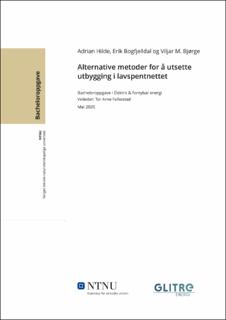| dc.contributor.advisor | Folkestad, Tor Arne | |
| dc.contributor.author | Hilde, Adrian | |
| dc.contributor.author | Bogfjelldal, Erik | |
| dc.contributor.author | Bjørge, Viljar Monason | |
| dc.date.accessioned | 2020-08-16T16:02:37Z | |
| dc.date.available | 2020-08-16T16:02:37Z | |
| dc.date.issued | 2020 | |
| dc.identifier.uri | https://hdl.handle.net/11250/2672208 | |
| dc.description.abstract | Hovedmålet med oppgaven er å analysere hvordan lastflytting kan utsette utbygginger i
lavspentnettet. For å svare på dette er en krets i lavspentnettet simulert med tre ulike tiltak som
bygger på lastflytting. Tiltakene er batterienergilagringssystem i nettet, lastflytting hos abonnenter,
og begrenset inntakssikring for nytilknytninger. Som sammenligningsgrunnlag er det vurdert to
tradisjonelle løsninger: bytte av linje og spenningsbooster.
Lavspentkretsen, med tilhørende komponenter og historisk lastflyt beregnet fra AMS-data, er hentet
fra nettinformasjonsverktøyet Powel NetBas. Dataene er benyttet til å lage en forenklet modell i
Microsoft Excel. Modellen er konstruert for å vurdere spenningsnivået hos de syv ytterste
abonnentene i kretsen. Simuleringen tar utgangspunkt i perioden med størst belastning, og tar
hensyn til fremtidig lastutvikling modellert som lastøkning og tillegglaster. Basert på resultatene fra
simuleringen er det gjort et anslag på hvor lenge tiltakene kan utsette utbygging av kretsen.
Av de analyserte lastflyttingstiltakene konkluderes det med at lastflytting på abonnentnivå, har
størst potensial til å redusere spenningsfall og dermed utsette nettutbygging. Likevel er det
tradisjonelle tiltak som bytte av linje og spenningsbooster som utsetter utbyggingen lengst, og er
mer hensiktsmessige å innføre i den analyserte kretsen. Lastflytting hos abonnenter er kun
undersøkt for et fåtall abonnenter, og derfor anbefales det å gjøre ytterligere undersøkelser av
hvordan flere abonnenter med lastflytting vil påvirke nettet. | |
| dc.description.abstract | The objective for this thesis is to analyse how peak shaving can delay development in the
low-voltage network. To answer this, a circuit in the low-voltage network is simulated with
three different measures based on peak shaving. The measures considered are battery energy
storage system located in the grid, peak shaving at customer level and limited intake fuses for
new customers. To have a basis for comparison, there are two traditional solutions to
consider: changing a power line and voltage regulator.
The low-voltage circuit, with associated components and historic load flow (calculated from
AMS-data) is retrieved from Powel NetBas. This data is used to make a simplified model in
Microsoft Excel. The model is constructed to consider the voltage level of the last seven
customers in the circuit. The simulation is based on the period with the highest load, and also
takes future load development into consideration, modelled as a percentage load increasement
and additional loads. Based on the results from the simulation, an estimate is made on how
long the measures can delay the development within the network.
In conclusion of the analysed peak shaving measures, peak shaving at the customer level has
shown to be the measure with the most potential to reduce voltage drop, and therefore delay
the development. Although it is the traditional solutions like changing the power line and
voltage regulator that delay the development the most, and that they are also considered the
most expedient measures to introduce. Peak shaving at customer level has only been
simulated with a few customers, therefore it is recommended that this is investigated more
thoroughly, to see what impact peak shaving can have upon the low-voltage network within a
larger customer sample size. | en |
| dc.publisher | NTNU | |
| dc.title | Alternative metoder for å utsette utbygging i lavspentnettet | |
| dc.type | Bachelor thesis | |
